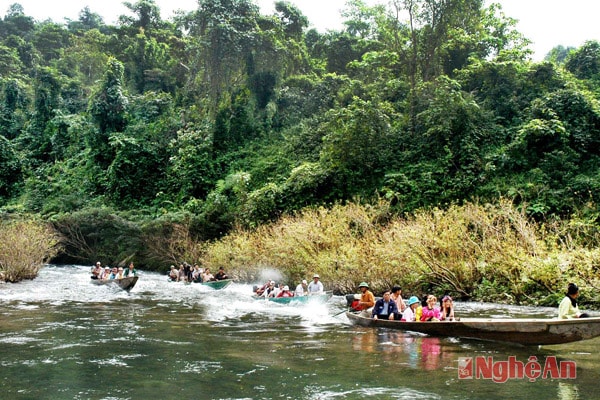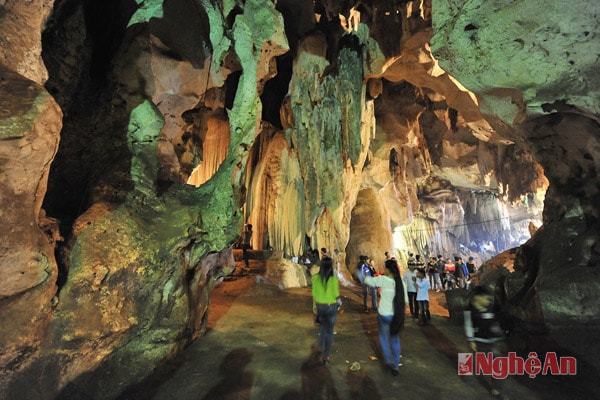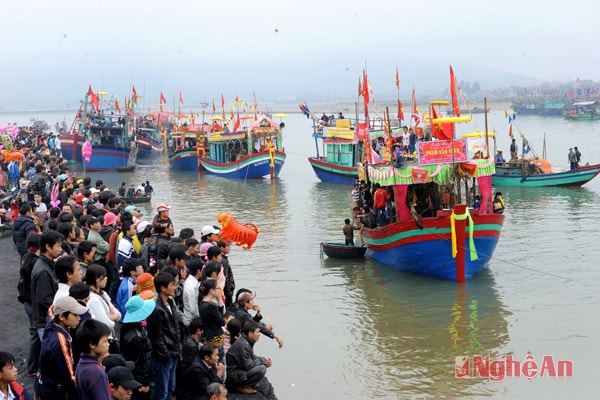Lesson 3: The road to Nghe An is winding...
(Baonghean) -On the Central Heritage Road, Nghe An is known as a land rich in historical traditions, gathering many unique cultural values. Not only is it endowed with abundant natural resources, but this place also has unique spaces that attract friends and visitors from near and far.
 |
| Giang River tourism in Pu Mat National Park. Photo: Sy Minh |
| RELATED NEWS |
|---|
With its geographical location and unique characteristics, Nghe An has many factors to promote its strengths and expand international cooperation in various fields. Therefore, the opening of the Vinh - Vientiane flight route by Nghe An province in early 2014 has shown its proactiveness in seizing opportunities, gradually affirming the role and position of a land in the trend of integration and development.
In the chain of attractive destinations of Nghe An, if Vinh City is the center, here everyone will have moments of serenity and peace when visiting Ho Chi Minh Square and Uncle Ho Monument. On an area of 11 hectares, Ho Chi Minh Square and Uncle Ho Monument are the places where important activities of the province take place. The project was completed in 2003, on the occasion of the 113th anniversary of President Ho Chi Minh's birthday. The project shows the respect of millions of Nghe people for Uncle Ho - National liberation hero, world cultural celebrity and outstanding son of the homeland. Ho Chi Minh Square and Uncle Ho Monument have become a proud spiritual and cultural symbol of Nghe people.
 |
| Kim Lien - Nam Dan relic site. |
If anyone knows that, in the two resistance wars against French colonialism and American imperialism, Vinh City was heavily damaged, without a single intact house left, then they will know how proud Vinh City residents are of the city's rise and rise after the war. Most of the architectural works, temple systems, pagodas, shrines in Nghe An in general and Vinh City in particular were restored after the end of the war. However, it is not difficult to see that the temples and pagodas all have an architecture that blends Mahayana Buddhism, Confucianism and Taoism from the 16th century to the end of the 19th century. In the space of 104.96 km2, Vinh City has a fairly dense distribution of attractive tourist attractions. That is the Vinh Citadel system built in 1804 under King Gia Long. The citadel was also continuously repaired and reinforced by the following kings of the Nguyen Dynasty. Since its construction, the citadel has been equipped with weapons for combat and defense. This project also aims to create a strategic political and military center in a historical period of the country. After many times of restoration and repair, Vinh Citadel has become a unique highlight in the cultural and historical space of Vinh City, a symbol of the perseverance in the spirit of Nghe An people.
If you come to Laos or Thailand, you will see that Buddhism dominates almost completely the ideology of the people, as well as all the tangible and intangible values of these two countries. In Vinh City, Nghe An, 50 minutes flight from Vientiane, there is a convergence of the beliefs and spirituality of Buddhism, Taoism, Confucianism and Christianity. The majority of residents of Vinh in particular and Nghe An in general always claim that they do not follow any religion or belief, but in fact, many people go to pagodas, temples and shrines to pray for the best things for their lives and families. This is most clearly shown in works such as Can Linh Pagoda (also known as the nun's pagoda), Hong Son Temple, King Quang Trung Temple... These architectural works are not only places for cultural, spiritual and religious activities but are truly interesting stops when tourists come to Vinh City.
 |
| Cua Lo beach. |
 |
| Bua Cave - Quy Chau. |
Less than 20 km from Vinh City is the Kim Lien relic site, Nam Dan, the hometown of President Ho Chi Minh, the place associated with his childhood. The Kim Lien relic site is one of the four most important relic sites in Vietnam about the life and career of Uncle Ho. On an area of 205 hectares are sites and relic clusters that have extremely important meanings in the spiritual life of the people of Nghe An and the whole country. That is the simple thatched house of Uncle Ho's family, the house of his paternal and maternal grandfathers, the Nguyen Sinh and Hoang family temples, and artifacts closely associated with the childhood of President Ho Chi Minh, such as Coc well, the forge of Mr. Dien, the banyan tree relic, the lakes of bright pink lotus flowers... In the system of the Kim Lien relic site, there is also a very unique work in terms of architecture and space, that is the tomb of Mrs. Hoang Thi Loan, Uncle Ho's mother, built on the Dai Hue mountain range in the Chung Mountain relic cluster. In May 2012, Kim Lien Relic Site was recognized by the Government as a special national relic site. This once again affirmed the historical and cultural role of President Ho Chi Minh and his relatives in the development of the homeland and the country.
Also in Nam Dan district, there are other attractive destinations such as the relic site and temple of King Mai Hac De, who made great contributions in the resistance war against the invasion of the Tang Dynasty (China); the memorial of the patriot Phan Boi Chau. Besides, in Nam Dan district, there are still preserved elements of profound spiritual and mental value, such as: Sen Village Festival, Mai King Festival, especially folk songs, Vi Dam with identity that cannot be found anywhere else.
Coming to Nghe An, people are not only attracted by historical and religious works, but also enjoy the majestic space of the western mountainous region. About 120 km from Vinh City, in Con Cuong district is Pu Mat National Park. This biosphere reserve is considered to be of the most important in the world. Here, experts have identified 42 species of large animals, 20 species of small animals, 295 species of birds, 39 species of bats, 12 species of lizards, 25 species of snakes, 23 species of frogs, 82 species of fish, 21 species of turtles, nearly 400 species of butterflies. Among them are particularly rare species such as: saola, tiger, Truong Son mang, elephant, striped rabbit... Regarding the flora, domestic and foreign scientists have investigated and collected samples of 2,494 species, including some precious species such as: po mu, sa mu, pinnate pine, cycad, orchid, Hainan star...
Pu Mat National Park also has very impressive landscapes such as Giang River with blue water all year round, Khe Kem waterfall, enough to make anyone who has ever set foot there flutter. If you make a journey to the core of Pu Mat, everyone can enjoy the mysterious space of primeval forests with thousands of years old sa mu trees. Also in Con Cuong district, the buffer zone of Pu Mat National Park has formed eco-tourism villages of Thai ethnic people in Mon Son and Luc Da communes. The image of stilt houses looming in the blue mist on the mountainside has the power to move and fascinate any tourist who has ever visited.
 |
| Con Temple Festival. |
But the western mountainous region of Nghe An not only has Pu Mat National Park in Con Cuong district, but also has two other biosphere reserves in Que Phong and Quy Chau districts. These are Pu Huong and Pu Hoat National Parks. There are few places in Vietnam that have such unique natural heritages and values as Nghe An. On an area of nearly 14,000 square kilometers of mountains and forests, the favor of nature has created a rich and romantic system of caves and waterfalls. These are Bua cave, Tham Om cave, Tham Chang cave in Quy Chau district; Xao Va waterfall, 7-storey waterfall in Que Phong district. Archaeological history also proves that the western region of Nghe An is also the birthplace of ancient Vietnamese people. There are sites associated with the formation and development of Vietnamese people during the Dong Son culture period.
The archaeological site in Tham Om cave or Lang Vac (Thai Hoa town) has clearly demonstrated this. Associated with the landmarks and landscapes are the unique festivals held annually, such as: Hang Bua Festival in Quy Chau, Chin Gian Temple Festival in Que Phong, Lang Vac Festival in Thai Hoa town. Notably, the attraction of the Western Nghe An region also comes from the rich customs and practices of many ethnic groups living here. The presence of the cultural values of the Kinh, Thai, Mong, Kho Mu, Tho ethnic groups has created a colorful space, which does not lose its unique features but also does not affect the harmony and friendliness inherent in the local people.
It would be a mistake to come to Nghe An without exploring sea tourism activities. With 82 km of coastline, the central province of North Central Vietnam possesses one of the advantages to promote the potential of the economy, which is becoming increasingly important in the current context. The center of sea tourism service exploitation activities is the beach in Cua Lo Town. Only 20 km from Vinh City, Cua Lo has a gently sloping beach, clear blue water with a length of more than 10 km. For many years, Cua Lo has attracted a large number of tourists from all over to relax. In 2013, Cua Lo beach welcomed more than 2.1 million tourists, of which 5,400 were foreign visitors. Revenue from tourism activities reached 1,460 billion VND. Up to now, Cua Lo Town has 246 accommodation establishments, 6,543 rooms with nearly 13,200 beds. In the policy of developing the smokeless industry of Nghe An province, Cua Lo is always identified as a key area in exploiting tourism services.
Every year, this coastal town hosts many typical festivals such as: Cua Lo River Festival, Boat Racing Festival, Fishing Festival, Van Loc Temple Festival... Visitors to Cua Lo can also drift along the waves in the night sky to catch small, sparkling squids, or be amazed on small boats crossing the waves to Ngu Island with a system of spiritual works on this small green island. Sea tourism in Nghe An is also known in Quynh Luu district with beautiful beaches in Quynh Bang and Quynh Phuong communes, or Dien Thanh commune, Dien Chau district. If you want to enjoy a more comfortable and luxurious space, people can go to a high-class resort with Bai Lu resort in Nghi Loc district.
Not only as beautiful as the song: The road to Nghe An is winding / Green mountains and blue water like a picture, Nghe An also has nearly 1,000 large and small historical relics. That is not to mention other intangible heritages such as folk literature, folk songs - folk dances, and the nuances of the diverse and rich spiritual life of the people living along the legendary Lam River. All of these create the soul of a land that never ceases to be charming.
(To be continued)
Khanh Ly - Dao Tuan






